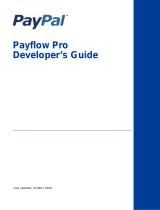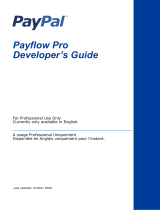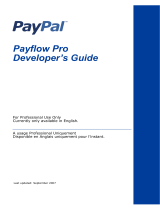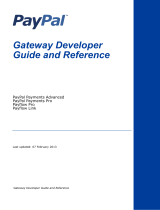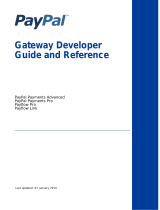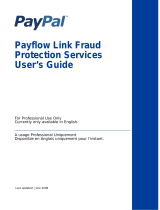Page is loading ...

Website Payments
Pro Payflow Edition
Developer’s Guide
Last updated: November 2009

PayPal Website Payments Pro Payflow Editiion Developer’s Guide
Document Number: 200016.en_US-200911
© 2009 PayPal, Inc. All rights reserved. PayPal is a registered trademark of PayPal, Inc. The PayPal logo is a trademark of PayPal, Inc. Other
trademarks and brands are the property of their respective owners.
The information in this document belongs to PayPal, Inc. It may not be used, reproduced or disclosed without the written approval of PayPal, Inc.
Copyright © PayPal. All rights reserved. PayPal (Europe) S.à r.l. et Cie., S.C.A., Société en Commandite par Actions. Registered office: 22-24 Boulevard
Royal, L-2449, Luxembourg, R.C.S. Luxembourg B 118 349.
Consumer advisory: The PayPal™ payment service is regarded as a stored value facility under Singapore law. As such, it does not require the approval
of the Monetary Authority of Singapore. You are advised to read the terms and conditions carefully.
Notice of non-liability:
PayPal, Inc. is providing the information in this document to you “AS-IS” with all faults. PayPal, Inc. makes no warranties of any kind (whether express,
implied or statutory) with respect to the information contained herein. PayPal, Inc. assumes no liability for damages (whether direct or indirect), caused
by errors or omissions, or resulting from the use of this document or the information contained in this document or resulting from the application or use
of the product or service described herein. PayPal, Inc. reserves the right to make changes to any information herein without further notice.

Website Payments Pro Payflow Edition Developer’s Guide 3
Contents
Preface . . . . . . . . . . . . . . . . . . . . . . . . . . . . . . . . . . 7
About This Guide. . . . . . . . . . . . . . . . . . . . . . . . . . . . . . . . . . . . . . . . 7
Intended Audience . . . . . . . . . . . . . . . . . . . . . . . . . . . . . . . . . . . . . . . 7
Related Documentation . . . . . . . . . . . . . . . . . . . . . . . . . . . . . . . . . . . . 7
How to Contact Customer Support. . . . . . . . . . . . . . . . . . . . . . . . . . . . . . . 8
Revision History . . . . . . . . . . . . . . . . . . . . . . . . . . . . . . . . . . . . . . . . 8
Chapter 1 Introduction . . . . . . . . . . . . . . . . . . . . . . . . . 9
About Website Payments Pro Payflow Edition. . . . . . . . . . . . . . . . . . . . . . . . . 9
Payflow SDK Version . . . . . . . . . . . . . . . . . . . . . . . . . . . . . . . . . . . 9
Host Addresses . . . . . . . . . . . . . . . . . . . . . . . . . . . . . . . . . . . . . . 9
How Direct Payment Processing Works . . . . . . . . . . . . . . . . . . . . . . . . . . . 10
Chapter 2 Downloading, Installing, and Activating . . . . . . . . . .11
Supported Platforms . . . . . . . . . . . . . . . . . . . . . . . . . . . . . . . . . . . . . 11
Preparing the Payflow Client Application . . . . . . . . . . . . . . . . . . . . . . . . . . 11
Activating Your Payflow Pro Account . . . . . . . . . . . . . . . . . . . . . . . . . . . . 12
Chapter 3 Simple Payflow Transaction . . . . . . . . . . . . . . . . .13
Transaction Requests . . . . . . . . . . . . . . . . . . . . . . . . . . . . . . . . . . . . 13
Request Contents . . . . . . . . . . . . . . . . . . . . . . . . . . . . . . . . . . . . 13
Data Modes for Sending. . . . . . . . . . . . . . . . . . . . . . . . . . . . . . . . . 13
Connection Parameters . . . . . . . . . . . . . . . . . . . . . . . . . . . . . . . . . 14
User Parameters. . . . . . . . . . . . . . . . . . . . . . . . . . . . . . . . . . . . . 15
Sale Transaction Example . . . . . . . . . . . . . . . . . . . . . . . . . . . . . . . . . . 15
Typical Sale Transaction. . . . . . . . . . . . . . . . . . . . . . . . . . . . . . . . . 16
Formatting Transactions . . . . . . . . . . . . . . . . . . . . . . . . . . . . . . . . . . . 16
Chapter 4 Performing Direct Payment Credit Card Transactions . . .17
About Direct Payment Credit Card Processing . . . . . . . . . . . . . . . . . . . . . . . 17
Considerations Regarding Your Website Integration . . . . . . . . . . . . . . . . . . 17

Contents
4 Website Payments Pro Payflow Edition Developer’s Guide
Parameters Used in Transactions . . . . . . . . . . . . . . . . . . . . . . . . . . . . . . 18
Submitting Sale Transactions . . . . . . . . . . . . . . . . . . . . . . . . . . . . . . . . 23
When To Use a Sale Transaction . . . . . . . . . . . . . . . . . . . . . . . . . . . . 23
Additional Parameters For Sale Transactions . . . . . . . . . . . . . . . . . . . . . . 24
Typical Sale Transaction Parameter String . . . . . . . . . . . . . . . . . . . . . . . 24
Submitting Authorization/Delayed Capture Transactions . . . . . . . . . . . . . . . . . . 24
When To Use Authorization/Delayed Capture Transactions. . . . . . . . . . . . . . . 25
Required Authorization Transaction Parameters . . . . . . . . . . . . . . . . . . . . 25
Typical Authorization Transaction Parameter String. . . . . . . . . . . . . . . . . . . 25
Required Delayed Capture Transaction Parameters . . . . . . . . . . . . . . . . . . 25
Delayed Capture Transaction: Capturing Transactions for Lower Amounts. . . . . . . 27
Delayed Capture Transaction: Capturing Transactions for Higher Amounts . . . . . . 28
Delayed Capture Transaction: Error Handling and Retransmittal . . . . . . . . . . . . 28
Submitting Credit Transactions . . . . . . . . . . . . . . . . . . . . . . . . . . . . . . . 28
Required Credit Transaction Parameters . . . . . . . . . . . . . . . . . . . . . . . . 28
Credit Transaction Parameter Strings . . . . . . . . . . . . . . . . . . . . . . . . . . 30
Submitting Void Transactions . . . . . . . . . . . . . . . . . . . . . . . . . . . . . . . . 30
When To Use a Void Transaction . . . . . . . . . . . . . . . . . . . . . . . . . . . . 30
Required Void Transaction Parameters . . . . . . . . . . . . . . . . . . . . . . . . . 31
Example Void Transaction Parameter String . . . . . . . . . . . . . . . . . . . . . . 31
Recharging to the Same Credit Card (Reference Transactions). . . . . . . . . . . . . . . 32
When To Use a Reference Transaction . . . . . . . . . . . . . . . . . . . . . . . . . 32
Transaction Types that Can Be Used as the Original Transaction . . . . . . . . . . . 32
Fields Copied From Reference Transactions . . . . . . . . . . . . . . . . . . . . . . 33
Example Reference Transaction. . . . . . . . . . . . . . . . . . . . . . . . . . . . . 33
Using Address Verification Service . . . . . . . . . . . . . . . . . . . . . . . . . . . . . 34
Example Address Verification Service Request . . . . . . . . . . . . . . . . . . . . . 34
Example Address Verification Service Response . . . . . . . . . . . . . . . . . . . . 34
Card Security Code Validation . . . . . . . . . . . . . . . . . . . . . . . . . . . . . . . . 35
Example CVV2 Request. . . . . . . . . . . . . . . . . . . . . . . . . . . . . . . . . 35
Example CVV2 Response . . . . . . . . . . . . . . . . . . . . . . . . . . . . . . . . 35
Chapter 5 Responses to Transaction Requests . . . . . . . . . . . .37
Contents of a Response to a Credit Card Transaction Request . . . . . . . . . . . . . . . 37
Address Verification Service Responses From PayPal . . . . . . . . . . . . . . . . . . . 39
Card Security Code Results . . . . . . . . . . . . . . . . . . . . . . . . . . . . . . . . . 40
Normalized Results . . . . . . . . . . . . . . . . . . . . . . . . . . . . . . . . . . . 40
PayPal Card Security Code Results. . . . . . . . . . . . . . . . . . . . . . . . . . . 41
PNREF Value . . . . . . . . . . . . . . . . . . . . . . . . . . . . . . . . . . . . . . . . 41

Website Payments Pro Payflow Edition Developer’s Guide 5
Contents
PNREF Format . . . . . . . . . . . . . . . . . . . . . . . . . . . . . . . . . . . . . 41
RESULT Values and RESPMSG Text . . . . . . . . . . . . . . . . . . . . . . . . . . . . 42
RESULT Values for Transaction Declines or Errors . . . . . . . . . . . . . . . . . . . 42
RESULT Values for Communications Errors . . . . . . . . . . . . . . . . . . . . . . 48
Chapter 6 Testing Credit Card Transactions . . . . . . . . . . . . . .51
Testing Guidelines . . . . . . . . . . . . . . . . . . . . . . . . . . . . . . . . . . . . . . 51
Credit Card Numbers Used for Testing . . . . . . . . . . . . . . . . . . . . . . . . . . . 51
Testing Result Code Responses. . . . . . . . . . . . . . . . . . . . . . . . . . . . . . . 52
Appendix A Verbosity: Viewing Processor-Specific Transaction
Results . . . . . . . . . . . . . . . . . . . . . . . . . . . . . . .55
Supported Verbosity Settings . . . . . . . . . . . . . . . . . . . . . . . . . . . . . . . . 55
Changing the Verbosity Setting . . . . . . . . . . . . . . . . . . . . . . . . . . . . . . . 57
Appendix B Currency Codes . . . . . . . . . . . . . . . . . . . . . . .59
Appendix C Country Codes . . . . . . . . . . . . . . . . . . . . . . .61
Index. . . . . . . . . . . . . . . . . . . . . . . . . . . . . . . . . . . .67

Contents
6 Website Payments Pro Payflow Edition Developer’s Guide

Website Payments Pro Payflow Edition Developer’s Guide 7
Preface
About This Guide
Website Payments Pro Payflow Edition uses the Payflow gateway and Payflow Pro SDK to
send transactions to PayPal for processing. This product offers two payment solutions: PayPal
Direct Payment, to process credit card transactions, and PayPal Express Checkout, to process
PayPal transactions.
Website Payments Pro Payflow Edition Developer’s Guide introduces transaction processing
through the Payflow gateway and describes how to integrate Direct Payment credit card
processing.
NOTE:Direct Payment credit card processing is not a standalone feature. You must use Direct
Payment together with Express Checkout. Use this guide along with the companion
guide, Express Checkout for Payflow Pro, for details on integrating Express Checkout.
Intended Audience
This guide is written for merchants who have signed up through PayPal Manager to use
PayPal as their processor for handling payment transactions on their website.
This guide assumes that its readers:
z Are experienced web or application developers
z Have a background in payments services
Related Documentation
For additional Payflow information, see the following related documentation:
z Express Checkout for Payflow Pro, for integrating Express Checkout as a payment
solution. Use this guide in conjunction with the Express Checkout guide for complete
information on Express Checkout transaction processing.
z PayPal Manager online help, for processing transactions manually, issuing credit cards, and
generating reports
z For additional help, see the Help Center at the following URL:
https://www.paypal.com/us/cgi-bin/helpweb?cmd=help
The Sample Code and Documentation section of the PayPal Developer Central home page
provides a link to the Payflow documentation.

How to Contact Customer Support
8 Website Payments Pro Payflow Edition Developer’s Guide
How to Contact Customer Support
For problems with transaction processing or your connection to the server, contact Customer
Support by opening a ticket on the under Contact Support tab at
http://www.paypal.com/mts.
Revision History
Revision history for PayPal Website Payments Pro Payflow Editiion Developer’s Guide.
TABLE 1.1 Revision history
Date Description
November 2009 Updated currency codes table.
October 2009 Updated currency codes.
Edits for technical accuracy.
March 2009 Added credit card line-item details parameters to Chapter 4, “Performing Direct Payment
Credit Card Transactions.”
November 2008
z Moved coverage of Express Checkout, originally in this guide, to a separate document,
Express Checkout for Payflow Pro.
z Removed Enroute and Jal from credit card ACCTTYPE description
z Added PPREF to transaction responses
z Updated table of RESULT values and RESPMSG text
z Added Currency Codes appendix
June 2008 Updated Preface.
Made
CURRENCY a required parameter.
March 2008 Added coverage of PayPal success with warning message, which can be returned by
PayPal when
RESULT=0.
February 2008 Added support for non-referenced credits.
Updated test and live host URLs.
November 2007 Explains how merchant can determine what SDK version they are using.
Explains more about
VERBOSITY parameter.
Explains how to eliminate
TRANSSTATE 106 results.
Updates Index to include an alphabetical listing of all Payflow parameters cited in the
guide.
Updated Figures 1.1 and 4.1 to show new PayPal logo.
Adds new transaction type N.
Includes other minor edits for technical accuracy.

Website Payments Pro Payflow Edition Developer’s Guide 9
1
Introduction
This chapter introduces the Website Payments Pro Payflow Edition product and provides an
overview of its Direct Payment credit card processing payment solution.
About Website Payments Pro Payflow Edition
Website Payments Pro Payflow Edition uses the Payflow gateway and Payflow Pro SDK to
send transactions to PayPal for processing. It is available from the PayPal Manager
Downloads page as a .NET or Java library, or you can build your own API by posting directly
to the servers via HTTPS.
With Website Payments Pro Payflow Edition, you get the payment processing capabilities of a
merchant account and gateway – plus much more. It is an all-in-one payment solution that
includes:
z Express Checkout, which allows PayPal account holders to check out fast with saved
information, and enables you to gain incremental sales from PayPal’s growing base of
users.
z Direct Payment credit card processing, which enables you to accept credit card payments
directly on your website. PayPal remains invisible, so you control the customer experience.
By integrating Direct Payment credit card processing with Express Checkout as part of the
Website Payments Pro Payflow Edition solution, you can accept all major payment types,
including PayPal, while working with a single provider that processes and manages all of your
online payments.
Payflow SDK Version
To determine the version of the Payflow SDK you are using, view a transaction in PayPal
Manager. In Transaction Details, check the value of Client Version. A value of 3x means you
are using a version 3 (V3) SDK; a value of 4x means you are using a version 4 (V4) SDK.
Host Addresses
Use the following host addresses for the Payflow V4 SDK:
z For live transactions, use payflowpro.paypal.com
z For testing purposes, use pilot-payflowpro.paypal.com

Introduction
How Direct Payment Processing Works
1
10 Website Payments Pro Payflow Edition Developer’s Guide
How Direct Payment Processing Works
Figure 1.1 illustrates the Direct Payment credit card processing flow. For credit card
transactions, customers can stay on your website as PayPal processes the payment in the
background.
FIGURE 1.1 Direct Payment credit card processing
The numbers in the flow identify these events:
1. On your website, the customer chooses to pay with a credit card and enters the credit card
number and other details.
2. The customer reviews the order.
3. When your customer clicks “Pay” to place the order, you send the Direct Payment request.
Within seconds, you receive the response confirming that the transaction has been
processed.
4. You transfer your customer to your order confirmation page.
The “Pay” button on your website sends the Direct Payment request over the Payflow gateway
to the server. The request includes the required information you collected from the customer
such as the amount of the transaction, the buyer’s credit card number, expiration date, browser
IP address, and an element that specifies whether the transaction is a final sale or an
authorization for a final amount that you capture in a subsequent transaction.
PayPal is completely invisible to your customer before, during, and after the purchase. PayPal
does not send an email receipt to the customer, nor does the customer’s credit card statement
indicate that PayPal processed the payment.
NOTE:Direct Payment credit card processing is not covered by the PayPal Seller Protection
Policy (SPP).

Website Payments Pro Payflow Edition Developer’s Guide 11
2
Downloading, Installing, and
Activating
The Payflow Software Development Kit (SDK) is a set of APIs to allow you to integrate
Website Payments Pro Payflow Edition (Payflow Pro) with your application or website.
IMPORTANT:Full API documentation is included with each SDK.
Supported Platforms
Payflow Pro is available on all major web server platforms in a variety of formats to support
your integration requirements. Payflow Pro is available as a .NET or Java library, or you can
build your own API by posting directly to the Payflow servers via HTTPS.
Preparing the Payflow Client Application
Unless you are building your own API and using HTTPS to post to the servers, you will need
to obtain the Payflow SDK. Follow these steps.
1. Download the Payflow SDK.
From the SDKs and Downloads page linked to the Library tab on PayPal Developer
Central, download the Payflow SDK appropriate for your platform.
2. Extract the files to a local directory.
3. Configure your firewall.
If you have a stateful firewall, enable outbound traffic for SSL (port 443). The firewall
keeps state on the connection, and automatically permits the inbound response from
PayPal.
If you do not have a stateful firewall, enable inbound and outbound traffic for SSL (port
443). Outbound traffic permits the initial request by Payflow Pro, while inbound permits
the response from PayPal.
4. Read the Readme.txt file.
The Readme.txt file includes integration information and samples that illustrate how to use
the Payflow client application in your development environment.

Downloading, Installing, and Activating
Activating Your Payflow Pro Account
2
12 Website Payments Pro Payflow Edition Developer’s Guide
Activating Your Payflow Pro Account
When you are ready to activate your Payflow Pro account to begin submitting live
transactions, follow these steps:
1. Log in to PayPal Manager at
https://manager.paypal.com.
2. Click ActivateYour Account and follow the on-screen instructions.
3. Change the URL within your web or desktop application to point to the live Payflow
servers. For details on Payflow server URLs, see “Host Addresses” on page 9.

Website Payments Pro Payflow Edition Developer’s Guide 13
3
Simple Payflow Transaction
All Payflow transactions include a common set of required parameters. Additional parameters
are required depending on the transaction type.You can also provide many optional
parameters, depending on the results you want returned. For example, you can set the
VERBOSITY parameter to return PayPal processor-specific details rather than normalized
information if you are looking for this kind of information. VERBOSITY is described in detail
in Appendix A, “Verbosity: Viewing Processor-Specific Transaction Results.”
Transaction Requests
Request Contents
A transaction request includes:
z Connection parameters
z User parameters
z Parameters specific to the type of the transaction, such as a sale or an authorization
Data Modes for Sending
You can send parameter data in the transaction request to the Payflow server in either of two
modes:
z Name-value pair
z XMLPay
The examples in this guide are presented in name-value pair format. Name-value pair syntax
guidelines are described in “PARMLIST Syntax Guidelines” on page 14.
XMLPay is an XML syntax for payment requests and associated responses in a payment-
processing network. Instead of using name-value pairs, you can send XML documents to the
Payflow server based on the XMLPay 2.0 schema. For details on XMLPay, see XMLPay
Developer’s Guide in the Payflow Pro documentation on Developer Central.

Simple Payflow Transaction
Transaction Requests
3
14 Website Payments Pro Payflow Edition Developer’s Guide
Connection Parameters
The connection parameters are described below. Pass them in the format and syntax required
by the Payflow SDK and programming language that you are using. See your integration
documentation for details.
PARMLIST Syntax Guidelines
Follow these guidelines when creating the PARMLIST:
z Spaces are allowed in values.
z Enclose the PARMLIST in quotation marks (“”).
z Do not place quotation marks (“”) within the body of the PARMLIST.
z Separate all name-value pairs in the PARMLIST using an ampersand (&).
z Set the VERBOSITY transaction parameter to MEDIUM (default is LOW) if you want the
response to return more detailed information. For details, see Appendix A, “Verbosity:
Viewing Processor-Specific Transaction Results.”
Using Special Characters in Values
Because the ampersand (&) and equal sign (=) characters have special meanings in the
PARMLIST, name-value pairs like the following examples are not valid:
TABLE 3.1 Connection parameters
Parameter Description
HOSTADDRESS (Required) Payflow host name. See “Host Addresses” on page 9 for details on host
addresses.
HOSTPORT (Required) Use port 443.
PARMLIST (Required) List of parameters that specify the payment information for the transaction.
The quotation marks “ ” at the beginning and end are required. The following is an
example:
TRXTYPE=S&TENDER=C&PARTNER=PayPal&VENDOR=SuperMerchant&USER=Sup
erMerchant&PWD=SuperUserPassword&ACCT=5555555555554444&EXPDATE=
0308&AMT=123.00
The content of the PARMLIST varies by the type of transaction being processed. For
example, a Void transaction requires a different set of parameters than a Sale.
TIMEOUT (Required) Time-out period for the transaction. The minimum recommended time-out
value is 30 seconds. The client begins tracking from the time that it sends the
transaction request to the server.
PROXYADDRESS (Optional) Proxy server address. Use the PROXY parameters for servers behind a
firewall. Your network administrator can provide the values.
PROXYPORT (Optional) Proxy server port.
PROXYLOGON (Optional) Proxy server logon ID.
PROXYPASSWORD (Optional) Proxy server logon password.

Website Payments Pro Payflow Edition Developer’s Guide 15
Simple Payflow Transaction
Sale Transaction Example
3
NAME=Ruff & Johnson
COMMENT1=Level=5
To use special characters in the value of a name-value pair, use a length tag. The length tag
specifies the exact number of characters and spaces that appear in the value. The following
name-value pairs are valid.
NAME[14]=Ruff & Johnson
COMMENT1[7]=Level=5
NOTE:Quotation marks (“ ”) are not allowed even if you use a length tag.
User Parameters
All Payflow Pro transactions require the user parameters described below.
Sale Transaction Example
In addition to the connection and user parameters, each transaction type has additional
parameter requirements and can include a number of optional parameters as well. The
transaction parameters common to all processors are described in detail in Table 4.1 on
page 26.
To perform a credit card Sale transaction, you are required to pass the following parameters:
z TRXTYPE - The type of the transaction, such as S for Sale
z TENDER - The method of payment, such as C for credit card
z ACCT - The buyer’s credit card number
z AMT - The amount of the sale
TABLE 3.2 User parameters
Parameter Description
USER (Required) If you set up one or more additional users on the account, this value is the ID
of the user authorized to process transactions. If, however, you have not set up additional
users on the account, USER has the same value as VENDOR.
Limitations: Sixty-four alphanumeric, case-sensitive characters.
VENDOR (Required) Your merchant login ID that you created when you registered for the account.
Limitations: Sixty-four alphanumeric, case-sensitive characters.
PARTNER (Required) The ID provided to you by the authorized PayPal Reseller who registered you
for the Payflow SDK. If you purchased your account directly from PayPal, use PayPal.
Limitations: Sixty-four alphanumeric, case-sensitive characters.
PWD (Required) The password that you defined while registering for the account.
Limitations: Six- to thirty-two alphanumeric, case-sensitive characters.

Simple Payflow Transaction
Formatting Transactions
3
16 Website Payments Pro Payflow Edition Developer’s Guide
z EXPDATE - The expiration date of the credit card
Typical Sale Transaction
The following is a typical request transaction string for a Sale transaction.
TRXTYPE=S&TENDER=C&USER=SuperMerchant&PWD=SuperUserPassword&PARTNER=PayPal&
ACCT=5105105105105100&EXPDATE=1209&AMT=99.06&COMMENT1=Reservation&FIRSTNAME
=John&LASTNAME=Jones&STREET=123 Main St.&CITY=San
Jose&STATE=CA&ZIP=123451234&BILLTOCOUNTRY=US&CVV2=123&CUSTIP=0.0.0.0
Note that, besides the required Sale transaction parameters, the above string includes other
Payflow Pro parameters typically included in a credit card Sale transaction request.
When the transaction completes, the Payflow server returns a response string made up of
name-value pair response parameters. If the transaction is successful, a RESULT value of 0 is
returned. The value of PNREF identifies the transaction in future requests, and RESPMSG is a
string indicating whether the transaction was approved. This is an example response to a credit
card Sale transaction request:
RESULT=0&PNREF=VXYZ01234567&RESPMSG=APPROVED&AVSADDR=Y&AVSZIP=N&IAVS=Y&CVV2
MATCH=Y&PPREF=68W3371331353001F&CORRELATIONID=2dc60e253495e
Formatting Transactions
For details on how to format a transaction based on the above information, see the examples
and the supporting documentation provided with your SDK.

Website Payments Pro Payflow Edition Developer’s Guide 17
4
Performing Direct Payment Credit
Card Transactions
This chapter provides guidelines on how to implement PayPal Direct Payment transactions.
Direct Payment offers you credit card payment processing capability through PayPal directly
from the buyer’s credit card.
NOTE:Direct Payment credit card processing is not a standalone feature. You must use Direct
Payment together with Express Checkout. Use this guide along with the companion
guide, Express Checkout for Payflow Pro, for details on integrating Express Checkout.
About Direct Payment Credit Card Processing
Direct Payment credit card processing occurs in two steps — a real-time authorization and a
capture (settlement) of the funds that were authorized. You perform these two steps either as a
single Sale transaction or as two types of transactions, an Authorization and Delayed Capture,
depending on your business model.
For an Authorization, PayPal sends the transaction information to the cardholder’s issuing
bank. The issuing bank checks whether the card is valid, evaluates whether sufficient credit
exists, checks values such as Address Verification Service and card security codes, and returns
a response: Approval, Decline, Referral, or others. For details on Address Verification Service
and card security codes, see:
z “Using Address Verification Service” on page 34
z “Card Security Code Validation” on page 35
You receive the response shortly after you submit the transaction to PayPal. If the
Authorization is approved, the bank temporarily reserves credit for the amount of the
transaction to prepare to capture (fulfill) the transaction. The hold on funds typically lasts for
about a week.
Capturing a transaction (also known as settling a transaction) actually transfers the funds to
PayPal. Once the capture is approved, you will see the funds in your PayPal account.
Considerations Regarding Your Website Integration
In the design of your website integration, you should consider whether you want to store
information in your local database or use PayPal Manager reports to manage the data. You
may want to store shipping information in your system, or you may prefer to send the
information to PayPal with the transaction and report on it later.
NOTE:PayPal recommends that you do not store credit card numbers. If you must store
numbers, encrypt and store them behind properly configured firewalls. You should also
consider whether and how to use the merchant-defined fields COMMENT1 and

Performing Direct Payment Credit Card Transactions
Parameters Used in Transactions
4
18 Website Payments Pro Payflow Edition Developer’s Guide
COMMENT2 to help tie PayPal reports to your orders/customers or to report on other
information about the transaction.
If you want to integrate with other systems, such as order fulfillment and customer service,
you may want to connect these systems directly to your Payflow integration for capturing
funds, issuing refunds or credits, and so on. Alternatively, you may prefer to perform these
steps manually using PayPal Manager. Either way, PayPal recommends that you monitor
transaction activity using PayPal Manager.
Parameters Used in Transactions
PayPal accepts the parameters listed in table below. The table indicates whether the parameters
are required or optional.
To enable line-item support, which includes the parameters below, you must contact Merchant
Technical Support at
http://www.paypal.com/mts.
z L_NAMEn
z L_DESCn
z L_COSTn
z L_TAXAMTn
z L_QTYn
z L_SKUn
TABLE 4.1 Credit card transaction request parameters
Parameter Description
TENDER (Required) The method of payment. Values are:
z C = Credit card
z P = PayPal
Limitations: One alpha character.
TRXTYPE (Required) Indicates the type of transaction to perform. Values are:
z S = Sale transaction
z C = Credit
z A = Authorization
z D = Delayed Capture
z V = Void
z N = Duplicate transaction
NOTE:A type N transaction represents a duplicate transaction (version 4 SDK or
HTTPS interface only) with a PNREF the same as the original. It appears only
in the PayPal Manager user interface and will never settle.

Website Payments Pro Payflow Edition Developer’s Guide 19
Performing Direct Payment Credit Card Transactions
Parameters Used in Transactions
4
ACCT (Required) Credit card or purchase card number.
Limitations: A maximum of 19 numeric characters. This value may not contain
spaces, non-numeric characters, or dashes. For example, ACCT=5555555555554444
EXPDATE (Required) Expiration date of the credit card.
Limitations: Four numeric characters in mmyy format. For example, 1008 represents
November 2008.
ACCTTYPE (Optional) Credit card type. The following card types are supported:
z 0 = Visa
z 1 = MasterCard
z 2 = Discover
z 3 = AMEX
z 8= Other
AM
T (Required) Amount (US Dollars) U.S. based currency.
AMT=ITEMAMT + TAXAMT + FREIGHTAMT + HANDLINGAMT + INSURANCEAMT
- DISCOUNT
NOTE:You must set CURRENCY to one of the three-character currency codes for any
of the supported PayPal currencies. See CURRENCY in this table for details.
Limitations: Must not exceed $10,000 USD in any currency. Nine numeric characers
plus decimal (.) character. No currency symbol. Specify the exact amount to the cent
using a decimal point—use 34.00, not 34. Do not include comma separators—use
1199.95 not 1,199.95.
Nine numeric characters plus decimal.
CURRENCY (Required) The currency code. See Appendix B, “Currency Codes.”
NOTE:CURRENCY is applicable only to processors that support transaction-level
currency.
Limitations: Three characters.
BUTTONSOURCE (Optional) Identification code for use by third-party applications to identify
transactions.
Limitations: 32 alphanumeric characters.
CUSTIP (Optional) IP address of payer’s browser as recorded in its HTTP request to your
website. This value is optional but recommended.
NOTE:PayPal records this IP address as a means to detect possible fraud.
Limitations: 15-character string in dotted quad format: xxx.xxx.xxx.xxx
COMMENT1 (Optional) Merchant-defined value for reporting and auditing purposes.
Limitations: 128 alphanumeric characters.
T
ABLE 4.1 Credit card transaction request parameters
Parameter Description

Performing Direct Payment Credit Card Transactions
Parameters Used in Transactions
4
20 Website Payments Pro Payflow Edition Developer’s Guide
COMMENT2 (Optional) Merchant-defined value for reporting and auditing purposes.
Limitations: 128 alphanumeric characters.
CAPTURECOMPLETE (Optional) Indicates if this Delayed Capture transaction is the last capture you intend
to make. The values are:
z Y (default)
z N
NOTE:If CAPTURECOMPLETE is Y, any remaining amount of the original
reauthorized transaction is automatically voided.
Limitations: 12-character alphanumeric string.
CUSTOM (Optional) A free-form field for your own use.
Limitations: 256-character alphanumeric string.
CUSTREF (Optional) Merchant-defined identifier for reporting and auditing purposes. For
example, you can set CUSTREF to INVNUM.
Limitations: 12 alphanumeric characters.
CVV2 (Optional) A code that is printed (not imprinted) on the back of a credit card and used
as partial assurance that the card is in the buyer’s possession.
NOTE:CVV2 values are normalized to Y, N, and X values. The PayPal processor
values are returned when you set VERBOSITY parameter to MEDIUM.
Limitations: Four digits.
EMAIL (Optional) Email address of payer.
Limitations: 127 alphanumeric characters.
INVNUM (Optional) Your own unique invoice or tracking number.
Limitations: 127 alphanumeric characters.
ITEMAMT (Required if L_COSTn is specified) Sum of cost of all items in this order.
ITEMAMT = L_QTY0*LCOST0 + L_QTY1*LCOST1...L_QTYn*L_COSTn
Limitations: Nine numeric characers plus decimal (.) character. No currency symbol.
Specify the exact amount to the cent using a decimal point—use 34.00, not 34. Do not
include comma separators—use 1199.95 not 1,199.95.
Limitations: Nine numeric characters plus decimal.
TAXAMT (Required if L_TAXAMTn is specified) Sum of tax for all items in this order.
TAXAMT=L_QTY0*L_TAXAMT0 + L_QTY1*L_TAXAMT1 +...L_QTYn
*L_TAXAMTn
NOTE:You must set CURRENCY to one of the three-character currency codes for any
of the supported PayPal currencies. See CURRENCY in this table for details.
Limitations: Nine numeric characers plus decimal (.) character. No currency symbol.
Specify the exact amount to the cent using a decimal point—use 34.00, not 34. Do not
include comma separators—use 1199.95 not 1,199.95.
Nine numeric characters plus decimal.
T
ABLE 4.1 Credit card transaction request parameters
Parameter Description
/
